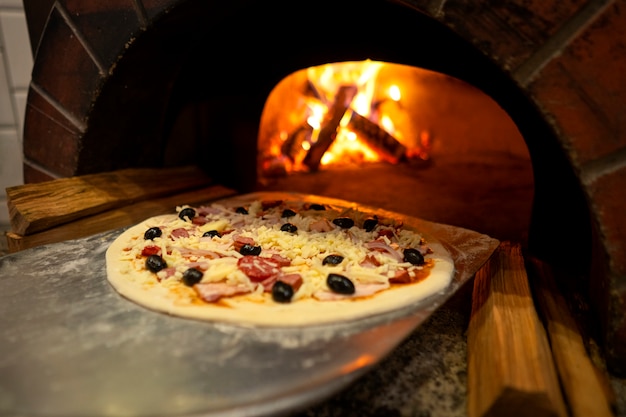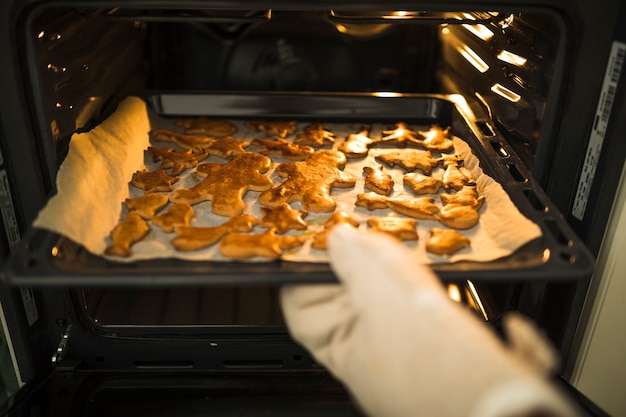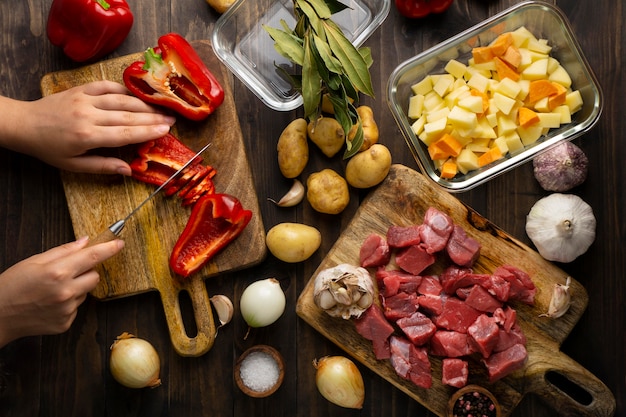Let's be honest, who doesn't adore a good pizza? It's the ultimate comfort food, perfect for a casual dinner with friends, a family gathering, or even a solo movie night. While there's nothing quite like a piping hot pizza fresh from a wood-fired oven, you don't need to be a professional pizzaiolo to create something truly delicious in your own kitchen.
This guide is packed with tips, tricks, and personal insights, gathered from years of pizza-making adventures. So, put on your apron, grab your favourite bottle of red (or a cheeky pint!), and let's embark on this pizza-making journey together.
Part 1: The Dough - The Foundation of a Great Pizza

1.1 The Power of a Good Dough
The foundation of any great pizza is, without a doubt, the dough. A good pizza dough should be light and airy, with a slight chewiness and a wonderfully crisp crust. Think of it as the blank canvas for all those delicious toppings.
1.2 My Go-To Dough Recipe - A Classic Neapolitan Base
Here's my tried and tested recipe, perfect for a classic Neapolitan pizza. This recipe strikes a perfect balance between simplicity and flavour:
Ingredients:
250g strong white bread flour (plus extra for dusting) – The backbone of the dough, provides structure and chewiness.
1 tsp instant yeast – The magic ingredient, responsible for the rise and airy texture.
1 tsp salt – Enhances flavour and strengthens the gluten in the dough.
1 tbsp olive oil – Adds richness and moisture to the dough.
180ml lukewarm water – Activates the yeast and helps to create a smooth and elastic dough.
Method:
1. Combine Dry Ingredients: Start by combining the flour, yeast, and salt in a large bowl. This ensures the yeast is evenly distributed.
2. Add Wet Ingredients: Add the olive oil and lukewarm water to the dry ingredients. Use your hands to mix until a dough starts to form.
3. Kneading Time: Turn the dough out onto a lightly floured surface. Knead for 5-7 minutes, until it becomes smooth, elastic, and slightly tacky. This process develops the gluten structure, which gives the dough its characteristic chewiness.
4. First Rise: Place the dough in a lightly oiled bowl, cover with cling film, and leave to rise in a warm place for 1-2 hours, or until doubled in size. This allows the yeast to work its magic and create air pockets, resulting in a light and fluffy texture.
1.3 Tips for Perfect Dough - Key Insights from a Pizza Enthusiast
Flour Matters: Strong white bread flour is essential for a good pizza dough. It has a higher gluten content than all-purpose flour, resulting in a dough with better elasticity and a sturdier structure.
Fresh Yeast is Best: While you can use instant yeast, fresh yeast produces a richer flavour and a more complex texture.
Kneading is a Workout: Don't skip kneading! It's essential for developing the gluten structure, which gives the dough its characteristic chewiness and resilience.
Warm Environment is Crucial: For the yeast to thrive, the dough needs a warm environment. I usually place the bowl in a warm, draft-free place, or even in a switched-off oven with a bowl of hot water. This creates a cozy and inviting space for the yeast to flourish.
1.4 The Importance of Rest - Allowing the Dough to Relax
After kneading the dough, let it rest for a good hour or two. This allows the gluten to relax and the dough to become more manageable. Think of it as a mini-spa treatment for your dough!
Part 2: The Sauce - A Flavourful Foundation

2.1 The Sauce: The Secret Weapon - More Than Just a Red Base
The sauce is what really brings the flavours together. Don't settle for a boring, watery sauce. You want something rich and flavourful, with a good balance of acidity and sweetness. This is where the magic happens, transforming a simple pizza base into a culinary masterpiece.
2.2 My Favourite Tomato Sauce - Simple Yet Delicious
Here's my recipe for a simple yet delicious tomato sauce that elevates the overall flavour profile:
Ingredients:
1 tbsp olive oil – Adds richness and depth of flavour to the sauce.
1 onion, chopped – Provides a sweet and subtle flavour that complements the tomatoes.
2 garlic cloves, minced – A classic flavour enhancer, adding warmth and aroma.
400g canned chopped tomatoes – The foundation of the sauce, providing a vibrant and tangy flavour.
1 tsp dried oregano – Adds a herbaceous and earthy note, complementing the tomato flavour.
Salt and pepper to taste – Adjust to your preference for seasoning.
Method:
1. Sauté the Base: Heat the olive oil in a saucepan over medium heat. Add the chopped onion and minced garlic and cook until softened, about 5 minutes. This creates a fragrant base for the sauce.
2. Simmer the Sauce: Stir in the chopped tomatoes, oregano, salt, and pepper. Bring to a simmer and cook for 15 minutes, or until the sauce has thickened slightly. This allows the flavours to meld and the sauce to develop a rich, concentrated flavour.
3. Blending for Smoothness: (Optional) Remove from the heat and blend with a hand blender, if you prefer a smoother texture. This is a personal preference, some people enjoy a slightly chunky texture, while others prefer a smoother consistency.
2.3 Sauce Variations - Explore New Flavour Horizons
Don't be afraid to experiment! You can add other herbs like basil, thyme, or rosemary, or even a pinch of chilli flakes for a spicy kick. The possibilities are endless, allowing you to personalize your sauce and create unique flavour combinations.
Part 3: Toppings - Unleashing Your Creativity

3.1 The Toppings: Unleash Your Creativity - The Star of the Show
Now, this is where things get really fun! You can go classic, with mozzarella, pepperoni, and mushrooms, or get creative and put your own spin on things. Toppings are what make your pizza truly unique, reflecting your personal taste and culinary ambitions.
3.2 My Top Toppings - A Collection of Favourites
Here are a few of my favourite pizza topping combinations:
Classic: Mozzarella, pepperoni, mushrooms, and onions – A timeless combination that always delivers.
Vegetarian: Roasted vegetables (peppers, zucchini, eggplant), mushrooms, artichoke hearts, and olives – A vibrant and colourful symphony of flavours.
Gourmet: Prosciutto, arugula, parmesan cheese, and truffle oil – A touch of luxury and sophistication for a truly special pizza experience.
Spicy: Hot salami, jalape??os, roasted red peppers, and chilli flakes – For those who like a bit of heat in their pizza life.
3.3 Top Tips for Toppings - Balancing Flavour and Texture
Less is More: Don't overdo it! Too many toppings can make the pizza soggy and overwhelmed. Keep it simple and focus on a few key flavours.
Pre-Cook When Necessary: Some toppings, like mushrooms and onions, benefit from pre-cooking. This helps them release their moisture and prevents the pizza from becoming soggy.
Strategic Cheese Placement: I like to put the cheese on after all the other toppings. This way, it melts evenly and doesn't get lost underneath a mountain of other ingredients. This ensures a gooey and delicious cheese layer that complements the toppings without dominating them.
Part 4: The Baking - Achieving that Perfect Crust
4.1 The Oven: Your Secret Weapon - The Key to a Crispy Crust
A good pizza oven is crucial for getting that perfect crispy crust. But don't worry, you don't need a fancy pizza oven to make a delicious pizza at home. A standard oven will do just fine, as long as you know the secrets to achieving that crispy crust.
4.2 Preheating is Key - Maximizing Oven Efficiency
Preheat your oven to the highest setting. Aim for around 250°C (480°F). This high temperature ensures that the crust cooks quickly and evenly, resulting in a golden-brown, crispy crust.
4.3 Baking Time - A Balancing Act of Time and Temperature
The baking time will vary depending on your oven and the size of your pizza. For a standard 12-inch pizza, expect to bake for around 8-10 minutes. Keep a close eye on the pizza and adjust baking time accordingly to achieve the desired level of doneness.
4.4 baking tips - Elevating Your Pizza Game
Pizza Stone Power: If you have one, use a pizza stone. It helps to absorb heat and distribute it evenly, resulting in a crispy crust with a beautiful, even browning.
Baking Sheet Backup: If you don't have a pizza stone, use a baking sheet lined with parchment paper to prevent sticking. The parchment paper acts as a barrier between the dough and the baking sheet, ensuring even cooking and easy removal.
Rotating for Even Cooking: For a perfectly cooked crust, rotate the pizza halfway through baking. This ensures that the heat is distributed evenly and prevents any part of the crust from burning before the rest is fully cooked.
Part 5: The Final Touch - Adding That Extra Pizzazz
5.1 Finishing Touches - Making Your Pizza Shine
Once the pizza is out of the oven, let it cool slightly before slicing. Then, it's time to add those final touches that really make it special. A sprinkle of fresh herbs, a drizzle of olive oil, or a grating of Parmesan cheese can transform your pizza into a culinary masterpiece.
5.2 My Favourite Garnishes - The Finishing Touches
Fresh Basil: A classic, and for good reason. The aroma and flavour of fresh basil complement the tomato sauce and cheese beautifully.
Parmesan Cheese: A touch of salty, nutty flavour that adds a delightful contrast to the richness of the cheese and sauce.
Red Pepper Flakes: For a kick of heat, adding a touch of spice and complexity to the overall flavour profile.
Drizzle of Olive Oil: To add richness and shine, highlighting the colours and textures of the toppings.
Part 6: Variations and Experimentation - Expanding Your Pizza Horizons
6.1 Beyond the Basic - Unleashing Your Inner Pizza Chef
Once you've mastered the basics, it's time to get creative! There are endless possibilities when it comes to pizza toppings and flavours. Don't be afraid to experiment, break the rules, and create your own signature pizza creations.
6.2 My Favourite Pizza Variations - Beyond the Traditional
White Pizza: Skip the tomato sauce and go for a creamy base with garlic, ricotta cheese, and mozzarella. A light and delicate option that showcases the flavour of fresh herbs and creamy cheeses.
Hawaiian Pizza: Yes, it's controversial, but I'm a big fan of pineapple, ham, and mozzarella. A sweet and savory combination that creates a unique and delightful flavour profile.
Calzone: A folded pizza filled with your favourite toppings. A delicious and satisfying alternative to a traditional pizza, allowing you to create a pocket of flavour.
Deep Dish Pizza: A thick, cheesy pizza perfect for indulging. A decadent and comforting option, offering a rich and satisfying experience.
6.3 Tips for Experimentation - Exploring New Flavour Frontiers
Embrace the Unknown: Don't be afraid to try new things! The beauty of homemade pizza is that you can experiment and create your own unique flavour combinations.
Global Inspiration: There are so many delicious pizza variations around the world. Try a Thai-inspired pizza with chicken, peanut sauce, and cilantro, or a Mexican-inspired pizza with chorizo, jalape??os, and salsa. The world of pizza is your oyster!
Part 7: Pizza-Making Tools - Essential Equipment for the Pizzaiolo
7.1 Tools of the Trade - The Right Tools for the Job
Having the right tools can make all the difference in your pizza-making journey. Here are some essentials for creating delicious and perfectly cooked pizzas:
Pizza Stone: As mentioned earlier, a pizza stone is highly recommended for achieving that crispy crust. It absorbs and distributes heat evenly, resulting in a beautiful, golden-brown crust.
Pizza Peel: A pizza peel is used to slide the pizza into and out of the oven, ensuring a smooth transfer without compromising the integrity of the crust.
Pizza Cutter: A good pizza cutter will make slicing your pizza a breeze. It cuts through the crust with ease, ensuring clean and even slices.
Rolling Pin: Useful for rolling out the dough evenly, ensuring a consistent thickness for uniform cooking.
Measuring Cups and Spoons: Essential for accurate ingredient measurements, ensuring that your dough and sauce come out just right.
Part 8: Troubleshooting - Addressing Pizza Dilemmas
8.1 Common Pizza Problems and Solutions - A Guide to Navigating Pizza Challenges
No matter how experienced you are, there will be times when things don't go as planned. Here are some common pizza problems and solutions:
| Problem | Solution |
|---|---|
| Dough is too sticky | Add a little more flour, a tablespoon at a time, until the dough is no longer sticky. This will help create a more manageable dough that's easier to work with. |
| Dough is too dry | Add a tablespoon of water at a time, until the dough is more pliable. This will help rehydrate the dough and restore its elasticity. |
| Pizza crust is not crispy | Preheat the oven to the highest setting and make sure the pizza stone or baking sheet is hot before adding the pizza. This ensures a quick and even cooking process, resulting in a crispy crust. |
| Pizza crust is burnt | Lower the oven temperature slightly or bake the pizza for a shorter amount of time. This will prevent the crust from burning before the rest of the pizza is cooked. |
| Pizza is soggy | Avoid overloading the pizza with toppings. Cook the toppings beforehand, if necessary. This will prevent the excess moisture from the toppings from making the crust soggy. |
Part 9: FAQs - Answers to Your Pizza Queries
9.1 What kind of flour should I use for pizza dough?
Strong white bread flour is the best choice for pizza dough. It has a higher gluten content than all-purpose flour, resulting in a dough with better elasticity and a sturdier structure, perfect for creating a crispy crust.
9.2 How long should I let the dough rise?
Let the dough rise for 1-2 hours, or until doubled in size. A warm environment will help the yeast to activate and make the dough rise quickly. This allows the yeast to work its magic, creating air pockets in the dough, resulting in a light and airy texture.
9.3 How hot should the oven be for baking pizza?
Preheat your oven to the highest setting, around 250°C (480°F). This high temperature ensures that the crust cooks quickly and evenly, resulting in a golden-brown, crispy crust.
9.4 Can I make pizza without a pizza stone?
Yes, you can bake pizza on a baking sheet lined with parchment paper. Just make sure the baking sheet is hot before adding the pizza. This will help create a crisp crust, although it may not be as crispy as when using a pizza stone.
9.5 What are some tips for making a crispy pizza crust?
To get a crispy crust, preheat your oven to the highest setting, use a pizza stone, and bake the pizza for a short amount of time. Also, avoid overloading the pizza with toppings. These steps help to ensure that the crust cooks evenly and develops a beautiful crispiness.
Part 10: The Joy of Pizza-Making - A culinary adventure
There's something truly satisfying about making your own pizza. It's a fun and rewarding experience, and you can customize it to your liking. So, gather your ingredients, put on some music, and get ready to create a pizza masterpiece!
And remember, practice makes perfect! The more you bake, the better you'll become at creating delicious and perfectly cooked pizzas. Enjoy the journey, experiment with different flavours, and most importantly, have fun!
Everyone is watching

Perfect Rice Every Time: The Ultimate Guide to Cooking Rice
Cooking TipsAs a self-proclaimed foodie, I've always been a bit obsessed with rice. It's the foundation of countless cuisi...

Ultimate Guide to Cooking the Perfect Thanksgiving Turkey
Cooking TipsThanksgiving. Just the word conjures up images of overflowing tables laden with delicious food, the scent of r...

The Ultimate Guide to Cooking Asparagus: Tips, Techniques, and Recipes
Cooking TipsAsparagus. The mere mention of this spring delicacy conjures up images of vibrant green spears, crisp and burs...

Can You Cook Spaghetti with Gasoline? (The Shocking Truth)
Cooking TipsWe've all seen those crazy internet trends. You know, the ones that make you wonder, "Did someone actually try...

Chorizo and Eggs Recipe: The Ultimate Guide
Cooking TipsRight, let’s talk about chorizo and eggs. You know, that classic Spanish dish that's always a winner. It's th...
